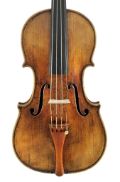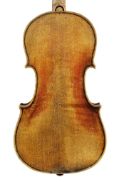Violin, Carlo Bergonzi, Cremona, 1723
Printed label with a decorative border: “Anno 1723 Carlo Bergonzi / fece in Cremona”Today, music historians agree that Carlo Bergonzi was apprenticed to Vincenzo Rugeri and continued to work for him in the years that followed. Bergonzi only began to affix his own labels to his instruments after his master’s death in 1719, so the 1723 violin was made during this early period. Some stylistic features are reminiscent of Rugeri’s work, whereas other details, such as the edgework or the purfling, indicate the influence of Bergonzi’s later role model, Antonio Stradivari. Yet the instrument also has features that are unmistakably characteristic of Bergonzi’s own work, such as the relatively high ribs or the typical shape of the volute with protruding eyes.
The body is fairly short, the arching of medium height. The halves of the two-piece belly are not from the same log. Whereas the wood on the bass side is very fine-grained, the annual rings of the wood on the treble side are very wide. A dendrochronological analysis of the belly was inconclusive for the bass side, but dated the treble-side wood at being from 1707. While the divided back exhibits very faint flames descending toward the edges, the flames of the rib wood are more pronounced. Stradivari’s influence shows in the f-holes, which are positioned very close together. The broad purfling is relatively close to the finely carved edge. The scroll design displays Bergonzi’s exquisite carving skill: The volutes are deeply cut and of a regular shape, which gives them a highly sculptural appearance. The golden-yellow ground is coated with a lustrous, red-brown color varnish that testifies to Bergonzi’s closeness to the Cremonese school of violinmaking. The back plate and the ribs still retain abundant traces of this varnish.





